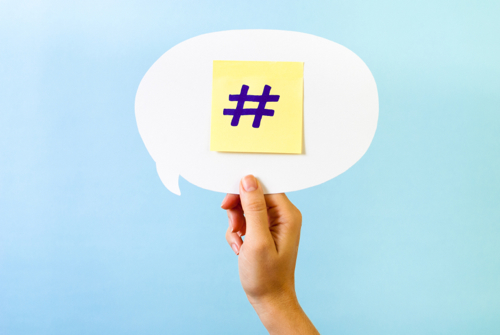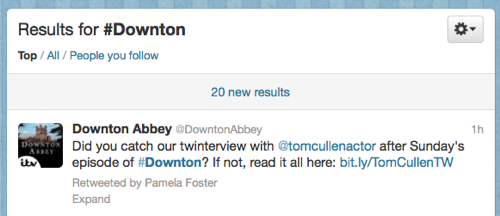A Beginner’s Guide to Hashtags
Categories: Twitter

Hashtags cause a lot of confusion but are simply clickable keywords within tweets. Put the # symbol immediately before a word or phrase (with no spaces or punctuation) and it becomes a link. Yes, keywords with or without the # symbol can be searched for on Twitter, and show up in the list of ‘trending topics’. The difference is that, when you include a hashtag within a tweet, it becomes a clickable link. In the way that the @ symbol before a username turns into a link to that person’s profile (e.g. @jonreed), the # symbol before a keyword becomes a link to a new timeline made up of everyone who has included that hashtag in their tweets (e.g. #TheArchers).
Hashtags are often used to play word games (for example #foodfilms – you know, The Hills Have Pies, Doctor Who and the Garlics, Cheeses of Nazareth etc.), or to discuss and follow an event in real time such as a television show or a conference. This may all sound a bit frivolous, but one of the best ways to get to grips with hashtags and how they work is to watch your favourite TV show and live-tweet it – whether it’s #XFactor, #doctorwho or #Downton. This simply means watching TV while tweeting about the show, making sure to include the hashtag in your tweets. You and other viewers tweeting along can then follow the discussion on Twitter on the hashtag timeline page, or by using an app such as Twitterfall.
I tweet along to or comment on TV or radio shows a lot on my personal @jonreed account (something I wouldn’t do at @getuptospeed or @publishingtalk, as it would be off-topic – no one wants to hear my opinions on #newsnight or #bbcqt there!) But those of you who follow me at @jonreed will notice I’m mostly tweeting about long-running UK radio soap #TheArchers on a Sunday morning, for example.
If you click on a hashtag, you will see at the top of the timeline ‘Results for #Downton‘ (or whatever hashtag you clicked on). Underneath this are three links to Top / All / People you follow. These help you filter the tweets you see. Top displays the most popular / retweeted tweets containing the hashtag; All shows you absolutely everything in real-time (and can include spam from people ‘hijacking’ a popular hashtag); and People you follow shows only tweets from people you follow who have included the hashtag.
Keep clicking the grey bar at the top that says (e.g.) 20 new results to see the latest tweets. This updates automatically without you having to refresh the page.
You don’t need to register hashtags anywhere – just make them up. However, conventions emerge. #doctorwho is more popular than #DrWho, for example, and it is a good idea to pre-announce the hashtag for a conference, since it can be confusing if there are several different versions flying around until the most popular one emerges.
Conference hashtags can be a great way to vicariously follow the action at conferences that you are interested in all over the world, as people tweet what is being said in the conference sessions from their smartphones or laptops. Some people wonder if conference organizers object to this or if their permission should be sought first. After all, people have paid to attend a conference, and now others can follow the action of a free! The truth is that most conference organizers want people to tweet from their events, as it gives them greater exposure. Sometimes they will even pay someone to be the official conference tweeter, or at least give them a free ticket. Attending a conference is a very different experience to following it on Twitter. It also enhances the experience for delegates present at the conference since they can comment on and discuss what is being said via a Twitter ‘back channel’ during the sessions. Sometimes tweets are even shown on a Twitter wall projected behind the speakers – though I think this can be distracting and counter-productive!
A number of hashtags have become popular on specific days of the week:
- #MusicMonday has been used to promote bands
- #CharityTuesday is a similar idea for highlighting charities on Twitter
- #WriterWednesday is used to give a shoutout to writers or share writing tips
- #FollowFriday or #ff is used on a Friday to suggest people to follow.
Use hashtags to tweet from conferences you attend, to recommend people to follow (using #ff), or to highlight industry-specific keywords within your tweets that people may search for. Or how about starting a hashtag word game on a theme related to your business?
You can also use hashtags to tweet about current events or other topics that are trending – so long as this is directly relevant to your business / what you are tweeting about and you are not gratuitously and randomly hijacking a popular hashtag to force your way into a timeline. You know the sort of thing: “Never mind the #uksnow, buy one of our supermops!” Or, more seriously, that notorious tweet from UK furniture store @HabitatUK in 2009 during political unrest in Iran: “#Mousavi Join the database for free to win a £1000 gift card.”
Finally, hashtags are no longer just about Twitter. They have also caught on with other networks: they can also be used in Pinterest, Google+ and Instagram – and now even Facebook.
FAQ: That’s all very well – but where is the # symbol on my keyboard??
Answer: A PC will normally have a # key visible on the keyboard – usually at the right-hand end of the middle row of keys, just next to the Enter key. On a Mac keyboard in the US, it is usually visible too, on the number 3 key (press Shift+3). However, UK Mac keyboards often cause confusion, because Shift+3 is the £ sign, and there is no # printed on the keyboard. Use Alt+3 instead.
Find out about marketing yourself with Twitter in Chapter 13 of Get Up to Speed with Online Marketing.


